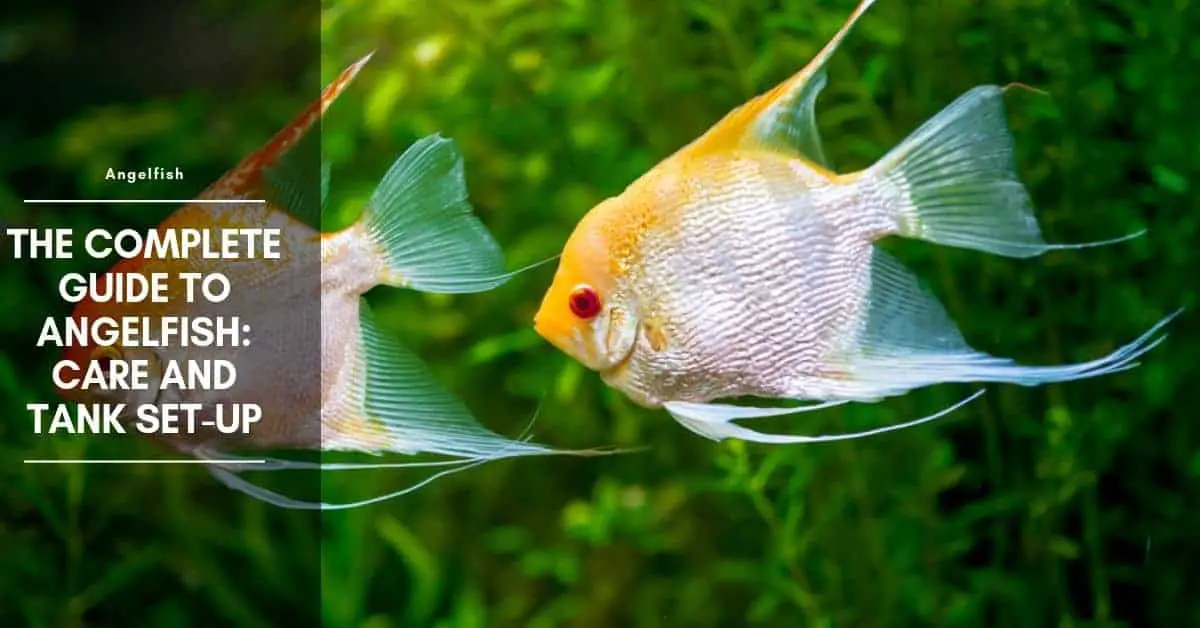The Angelfish (scientifically known as Pterophyllum) is a small genus of freshwater fish from the Cichlidae family. The Angelfish originates from the Amazon Basin, Orinoco Basin, and various other rivers located in tropical South America.
Angelfish have laterally compressed and round bodies with elongated triangular dorsal and anal-fin. This elongated and thin body shape allows these types of angelfish to camouflage themselves between plants and roots.
Wild Angelfish will typically have vertical stripes on their bodies to further aid in the camouflaging process. The camouflage allows for the Angelfish to efficiently hide from predators and ambush smaller fish it preys upon. Captively bred Angelfish come in a wide variety of colorations and scale designs due to selective breeding which stems from the popularity of the Angelfish genus.
Angelfish food
As a genus Angelfish are carnivorous and will eat other fish that are dramatically smaller than them. Angelfish grow to a large size, so it is essential to house them with fish of a similar size to avoid any unnecessary deaths. It is also necessary to provide your Angelfish with a lot of food.
How many times a day should you feed them?
Some types of angelfish should be fed at least twice a day, and it is therefore recommended to purchase your fish food in bulk to lower the cost. Better quality fish food will result in your fish having brighter and more colorful scales.
We recommend using a mixture of color-enhancing flakes, regular pelleted fish food, and frozen fish food to create variety. As previously mentioned freshwater Angelfish are carnivorous, and it is considered the best practice to feed them live prey such as bloodworms, daphnia, and brine shrimp if they are going to be kept in a community tank.
What is the best food for angelfish?
Feeding them all sorts of foods – Angelfish will take all sorts of foods. I’ve got the newest food of Vibra Bites, they eat that stuff up. They also take flakes, I happen to be a big fan of Vipan flake by SERA for a couple of different reasons.
First of all, it’s not your ordinary it’s kind of flakes, it’s kind of a brown flake – more natural, smells really good, and the fish tend to love it.
Frozen bloodworms work really good too. This is a great food to induce them to spawn because it helps fatten them up even though it seems to be mostly water, which is true, for some reason it helps fatten them up.
For fry I like to use a lot of the “bug bites”, and also one of my favorites and which are really easy to use because you can just stick them on the aquarium glass is the “O-nip tabs“.
As you can see I’m kind of a fan of Sera foods, I feed a few others besides Sera but had really good success with these foods.
Lifespan and Length
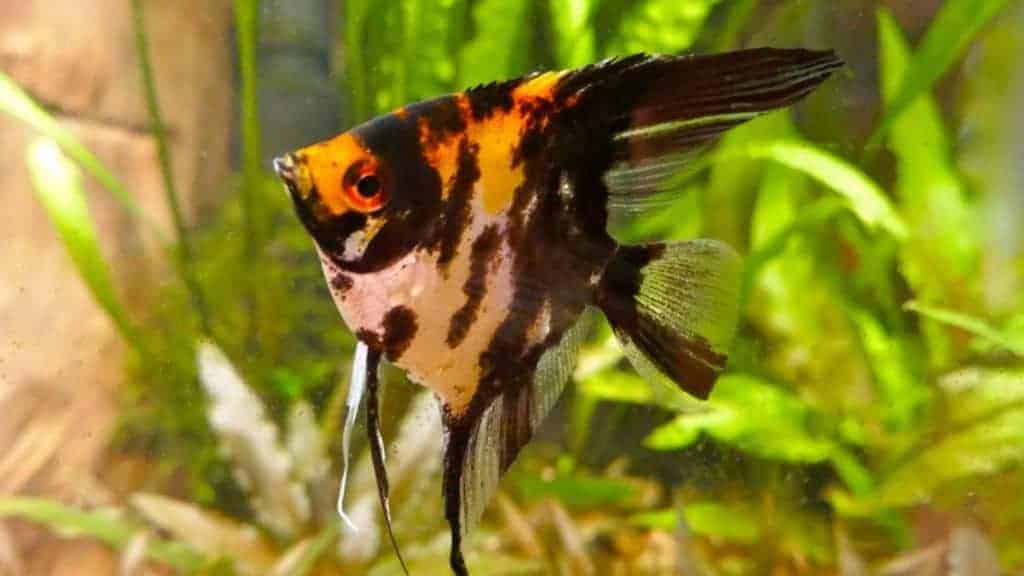
Angelfish commonly grow to between 4 and 6 inches (10 to 15cm) in body length. However, it is not uncommon for Angelfish to grow to be as large as 12 inches (30cm) in total length (if you include their dorsal and anal-fin)!
How long do angelfish live?
Angelfish will generally live for between 5 and eight years. However, it is not uncommon for Angelfish to live for up to 10 years if they are kept in ideal conditions and are provided with a lot of food.
Tankmates
As previously mentioned Angelfish are carnivorous, and it is, therefore, essential to plan what species you will house with them. It is considered the best practice to house all adult Angelfish separately as they tend to become territorial and aggressive. The following species can live peacefully with Angelfish who are not fully matured:
- Corydoras Catfish
- Loaches
- Tetra
- Red Cherry Shrimp and Ghost Shrimp
Angelfish Breeding and Eggs
The spawning site is usually a vertical surface, such as a piece of slate or a rigid leaf of one of the larger Amazon Swordplants (Echinodorus spp.) Surround the thermostatic heater with mesh to dissuade the fish from spawning nearby; heat will destroy the eggs. Angelfish eggs are susceptible to fungus, so you may need to add fungicide to the water. The female lays up to 1,000 eggs, which the pair guards until they hatch three days later.
Angelfish eggs are susceptible to fungus, so you may need to add fungicide to the water. The female lays up to 1,000 eggs, which the pair guards until they hatch three days later. A young pair of breeding for the first time may produce a much smaller number of eggs and then eat them, but they will usually spawn again within a month.
The newly hatched fry is transferred to a pit excavated in the substrate, where they are watched over by both parents. Feed the young on fry food initially, and then on brine shrimp. When they are free-swimming, they may nibble mucus off the flanks of the adults to supplement their diet.
Types Of Angelfish
Altum Angelfish
- ORIGINS: South America, occurring in Colombia and Venezuela in the central part of the Rio Orinoco.
- SIZE: 10 in (25 cm).
- DIET: Prepared foods, vegetable matter, small live foods.
- WATER: Temperature 82–86°F (28–30°C); soft (50–100 mg/l) and acidic (pH 6.0).
- TEMPERAMENT: Relatively peaceful, but territorial.
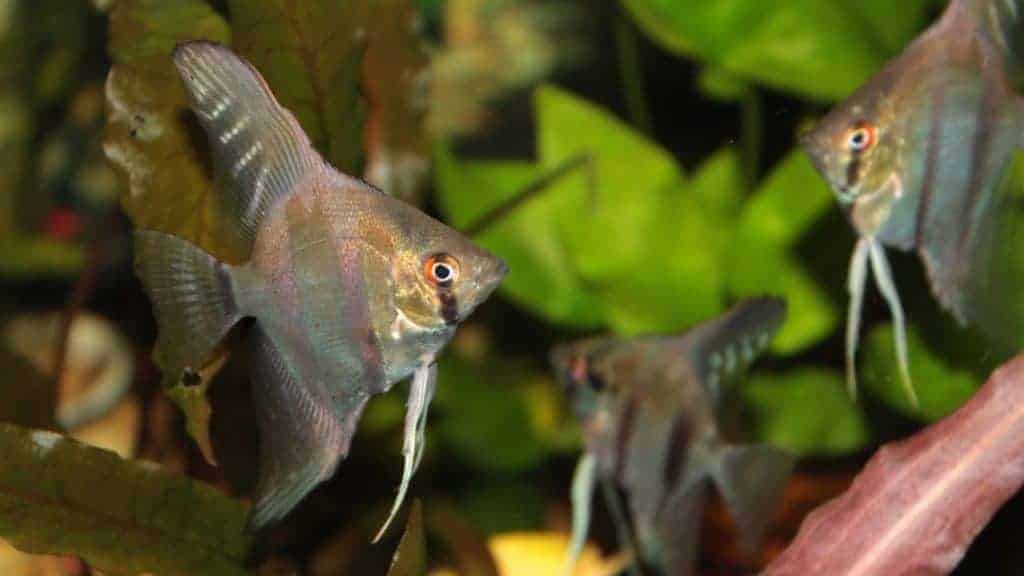
The Altum Angelfish has a much taller body than the Angelfish itself. It also has a flat area above the jaw and a steeper, less curved profile leading up to the dorsal fin. Altum Angelfish can be housed together in groups. As with the Angelfish, this species needs a relatively deep tank to accommodate its elongated shape.
Altum Angelfish are challenging to breed, but maintaining proper water chemistry may help to encourage spawning. Raising the water temperature in the Angelfish tank slightly and increasing the number of live foods in the diet. Check fish for signs of a white spot before buying, and also if the water temperature falls significantly for any period.
API STRESS COAT Aquarium Water Conditioner 16-Ounce Bottle
Tetra AquaSafe Plus, 8.45 Ounces, aquarium Water Conditioner And Dechlorinator, Model Number: 46798162681
$10.19 (as of January 2, 2026 17:14 GMT +03:00 - More infoProduct prices and availability are accurate as of the date/time indicated and are subject to change. Any price and availability information displayed on [relevant Amazon Site(s), as applicable] at the time of purchase will apply to the purchase of this product.)API TAP WATER CONDITIONER Aquarium Water Conditioner 16-Ounce Bottle
$8.48 (as of January 2, 2026 17:14 GMT +03:00 - More infoProduct prices and availability are accurate as of the date/time indicated and are subject to change. Any price and availability information displayed on [relevant Amazon Site(s), as applicable] at the time of purchase will apply to the purchase of this product.)Pterophyllum scalare – Freshwater angelfish
- ORIGINS: South America, occurring through much of the Amazon basin, eastward from Peru to Belem, Brazil.
- SIZE: 6 in (15 cm).
- DIET: Prepared foods, vegetable matter, and small live foods.
- WATER: Temperature 75–82°F (24–28°C); soft (50–100 mg/l) and acidic (pH 6.5).
- TEMPERAMENT: Relatively peaceful, but territorial.
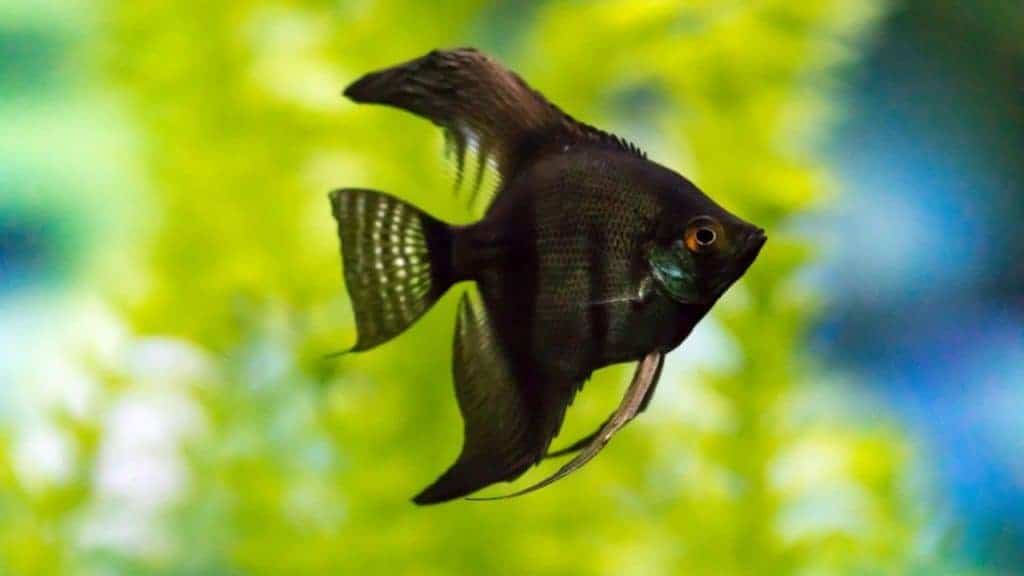
This graceful cichlid is among the most popular of all tropical fish. Young Angelfish is recommended for community aquariums, but their long fins make easy targets for fin-nippers such as Tiger Barbs. Furthermore, Angelfish will soon grow too large for the tank and may start to bully their companions.
It is best to house these fish in a single-species setup, where a pair may be persuaded to breed. The only way of visually distinguishing the sexes is when the female swells with eggs before spawning. In the early stages of pair bonding, the fish lock jaws and engage in mouth-wrestling, which may be mistaken for aggression.
Angelfish Tank Equipment CheckList
Below is a simple list of the most important things to own if you are planning on keeping fish at home. There are many other things that you can hold to help improve the quality of your aquarium. This list is the essentials that are necessary to provide a safe and healthy environment for your fish.
Aquarium
An aquarium of at least 20 gallons is recommended for beginners. However larger aquariums are generally more stable and can accommodate either more fish or larger fish. It is essential to purchase a specialized fish aquarium rather than a reptile vivarium. Aquariums are designed to hold the weight of the water and will not crack, or break, under pressure.
Aquarium Gravel
Gravel is the most common substrate used within aquariums. Gravel is coarse enough to allow water flow while also being fine sufficient to encourage the growth of nitrifying bacteria. Coarse sands, glass gravel, and Creek Stones are all excellent choices. Avoid limestone and calcium-based substrates as they will not promote healthy bacteria growth.
Aquarium Filter
Your aquarium filter should be rated to turn over at least 3 to 5 times the aquarium’s volume each hour. For small aquariums a Hang-On-Back filter is perfect. We recommend using a tried and tested filter, such as the Marineland Penguin Power Filters. They are proven to be reliable, easy to use, and have a high flow rate.
Replacement Filter
It is essential to always have a backup filter in case your primary one breaks. If you leave your angelfish in your tank without a working filtration system for too long, it will cause them to have severe health problems.
Heater
A heater is essential for limiting the chance of your fish getting diseases. It also allows for the keeping of tropical fish. Multiple water heater brands are reliable and affordable. There should be various available in your local pet store or aquarium store.
Water Test Kit
It is essential to have good quality and reliable water test kit. A good quality kit will allow you to test for cycling before introducing fish into your aquarium. Your water test kit is also the apparatus that alerts you to toxic aquarium conditions which could potentially harm your fish.
Aquarium Vacuum
The vacuum is an essential piece of cleaning maintenance. It will clear faces and debris from the substrate of your aquarium. Removal of debris will help to reduce the nitrates in the water and help to make your fish not feel stressed. There are multiple brands available that come in at various price points. We recommend the ‘Python No Spill Vacuum‘ — despite being relatively expensive, it is the most efficient, reliable, and least likely to spill water onto your carpet out of all the vacuums we have used.
Fish Net
Fish nets are useful for removing dead plant matter, and excess food and for moving your fish. They are an essential part of the transportation process as you should never touch live fish with your bare hands.
Aquarium Glass Scrubber
An aquarium glass scrubber is essential to keep your tank clean. It is a fish-friendly cleaning product that helps keep your aquarium looking fresh and aesthetically pleasing.
5-gallon Bucket
A 5-gallon bucket is a useful piece of equipment as you can store your fish in it in case of a tank emergency. A large bucket is also essential for transporting fish with spiny fins or fish that tend to bite through fish transportation bags.
Decorations
Decorations are a perfect way to improve the aesthetics of your aquarium while also providing your fish with an exciting area to explore. Typical decorations range from real and fake plants to specifically made underwater objects — such as castles and treasure chests. There should be a wide range of aquarium decorations available in your local pet store, aquarium store, and online.
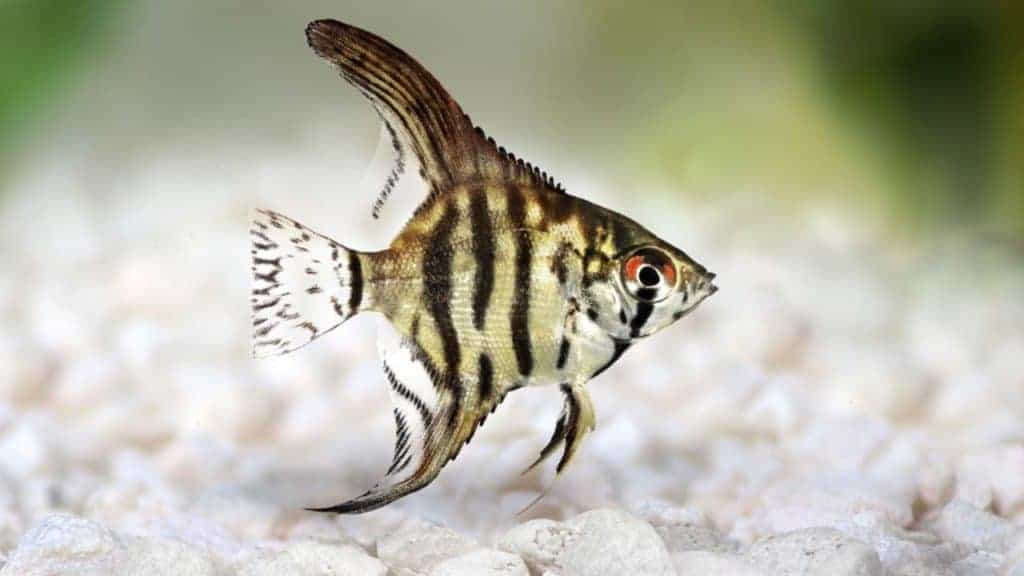
Aquarium Setup for All Types of Angelfish
Once you have purchased everything on the above checklist, it is now time to set up your aquarium. Before setting up your aquarium, it is crucial to place it on a hard flat surface. If the surface is slightly slanted, it can cause your fish stress and may end up cracking the aquarium glass due to a buildup in pressure.
If you have a large aquarium (anything over 30 gallons), it is recommended to place your tank on either a sturdy cabinet or the floor to make sure that it is safe and secure. It is essential to put your aquarium near a power socket as extension cables are not desirable for both safety and aesthetic reasons — water and electricity do NOT mix!
Cleaning the Substrate
Once you have chosen the location of your tank, it is essential to select and clean your substrate. Most people opt for some form of gravel to line the bottom of their aquariums. You must wash your substrate before putting it into the tank. To clean your substrate, place it into a bucket, and spray it with a high-powered hose. Once the bucket is filled clean the substrate by vigorously moving your hands through the bucket in a circular motion.
After a few minutes, remove dirty water from the bucket while leaving the substrate at the bottom of the bucket. Repeat this process at least four more times or until the water is visibly brighter. Some substrates may leave the water slightly cloudy, but this is nothing to worry about as the cloudiness will naturally settle in your tank over time. The cleaning process is essential to remove dust, bacteria, and any potential parasites that may have found their way into the substrate during the storage process.
Placing the Substrate
Once the substrate is clean, it is time to use it to line your aquarium. Gently place the cleaned substrate into the bottom of the tank. It is essential to line the tank slowly and gently to avoid cracking the glass. It is recommended to use a small scoop to speed up the process. Once you have lined the aquarium, it is vital to smooth the substrate into about a half-inch flat lining.
Filling the Aquarium with Water
It is recommended to fill your aquarium with a hose pipe. Filling an aquarium with buckets is a slow process, but it is possible if there is not a tap nearby. After the tank is full use a water de-chlorinator. Although there are no fish currently in the tank, chlorine and chloramines can build up over time. It is recommended to purchase a high-quality de-chlorinator as you will need to use it after every water change.
Heating and Lighting
It is considered the best practice to have two heaters in your aquarium. It is essential to purchase heaters that will comfortably fit into your tank and not take up too much of the swimming space. Higher wattage heaters are better since they save power and will put less stress on the heating system. Once you have chosen your heaters, you should stick them to the glass inside your aquarium.
It is crucial to place your heaters in a place that has a good water flow to help spread the warmer water throughout the tank. You should heat your tank to between 76 and 82 degrees Fahrenheit (24-5 to 28 degrees Celsius). Most heaters will display an orange light when they are on and working. Lights are typically placed above or behind the tank. It is crucial to purchase lighting that has a timer. Aquariums should not be directly lit for more than 8 hours a day.
Filter
The purpose of the filter is to remove excess food, dangerous chemicals, decaying organic matter, feces, and any other unwanted floating particles. Fish excrete waste constantly as they swim around in the water. If this waste is not removed quickly and efficiently, the toxins that angelfish are excreting will build up to a high concentration, which may cause the fish to poison themselves.
Filters are also a great way to keep your tank looking clean and to keep the water clear and cloudless. It is vitally important to the health of your fish to provide them with a sufficient filtration system. There are three main types of filtration systems used in aquariums which will be discussed below.
It is recommended to have multiple different types of filters within your aquarium. It will provide the best results and will provide a failsafe filtration system if one breaks down or stops functioning as desired.
Biological Filtration
Biological filtration involves bacteria, microorganisms, and fungi converting the waste your fish produces into less toxic substances. As previously mentioned, your fish excrete waste constantly as they swim and this waste, if not removed, will become poisonous to your fish. A biological filter will convert the ammonia in the waste into nitrite, and then the nitrite into nitrate.
Nitrate is dramatically less harmful than anomia and nitrite. However, nitrate does have some harmful side effects, such as causing a loss of appetite, eye problems, and kidney failures in your fish. Biological filtration is established during the cycling process. Biological filtration is necessary for every aquarium but should be accompanied by either mechanical or chemical filtration.
Mechanical Filtration
Mechanical filtration is the process of removing solid waste and unwanted particles. This filtration works by forcing the water to pass through a filter. The filter will not allow unwanted particles to pass through it. The most common materials used for strainers are a sponge, filter floss, special filter pads, and even aquarium gravel. The finer the material used for the strainer, the smaller the particles that can be caught.
However, more delicate materials will need to be rinsed and replaced more often since they will get plugged and dirtied at a faster rate. Many mechanical filters will use a mixture of fine and coarse materials to create their filters and to provide the optimal balance between water cleaning and filter maintenance.
It is essential to clean your filter regularly as it will help to optimize the filtration process. Leaving a dirty filter plugged in will prevent sufficient water flow and may even force water to flow around the filter itself.
Chemical Filtration
Either carbon or chemical resins provide chemical filtration. The resins extract toxins from the water in a similar way to a biological filter but are much more aggressive and effective.
Chemical filters are incredibly efficient until they are saturated with toxins. Once they are soaked, they provide no filtration and will, therefore, need to be changed as soon as possible. Typically 1 square inch of carbon can provide filtration to 2 gallons of water. Your water flow must allow for the entire tank volume to pass through the carbon filter. At least every 2 hours or it will not be sufficiently filtered.
Problems with Chemical Filtration
Chemical filtration has a few issues which make it not advisable for beginner fish keepers. If you use water that has a high amount of minerals or chemicals in it, this will vastly increase the rate at which your chemical filter becomes saturated.
Adding fish food, minerals, trace elements, having an overcrowded tank, or having insufficient water changes can also quickly over saturate your filter. If your filter becomes overly saturated and does not get changed, it can start to release the toxins back into the water which negates its previous filtration.
Cycling
Cycling is the most critical part of setting up your new aquarium. Fish waste and excretions produce ammonia, and as previously mentioned, this ammonia is toxic to fish. This ammonia is changed into nitrite and then into safe fish nitrate. Your aquarium is a delicately balanced ecosystem that is dependent on this nitrogen cycle. The process of destroying ‘bad’ bacteria generates ‘good’ bacteria that your fish need to survive.
Fishless Cycling
It used to be common to introduce hardy fish into your aquarium during the cycling process. The ammonium found in the fish waste helps to kick start the growth of bacteria and start the cycling process.
However, it is no longer considered a best practice as it is cruel and leads to either health problems or the death of the hardy fish. It is possible to add ammonia to the aquarium directly and do fishless cycling. Initially, 2-4ppm of ammonia should be added into your aquarium, with small amounts being added every few days.
Water change
10-15% water change every day during the cycling process is recommended. This will prevent the buildup of ammonia.
Introducing Fish
It is essential to leave your new tank for at least one day before adding any fish to it. It is considered the best practice to wait between 2-8 weeks before introducing fish. To make sure that the cycling process has fully ended and to minimize the chance of any fish dying. When adding new fish, make sure that the ammonia and nitrite levels do not dramatically spike. This will be harmful to both your old fish and the new ones.
Final Thoughts – Angelfish care
Before purchasing any fish, it is essential to understand that as a fish owner, you are responsible for the care and well-being of your fish. It is necessary to try and learn as much as you can about the fish you are considering keeping. You need to make sure that your lifestyle, household, and financial status are suited to provide your fish with the best possible care.
This guide has been designed to provide you with both precise and concise information about Angelfish’s basic needs. And to help you ensure your fish with the best quality care and aquarium practices. This guide also goes into the benefits of cycling and having a decent filtration system.

Hi, my name is Sean, and I’m the primary writer on the site. I’m blogging mostly about freshwater and saltwater aquariums, fish, invertebrates, and plants. I’m experienced in the fishkeeping hobby for many years. Over the years I have kept many tanks, and have recently begun getting more serious in wanting to become a professional aquarist. All my knowledge comes from experience and reading forums and a lot of informative sites. In pursuit of becoming a professional, I also want to inspire as many people as I can to pick up this hobby and keep the public interest growing.
Read more about Sean.
Please join also my Facebook group.

